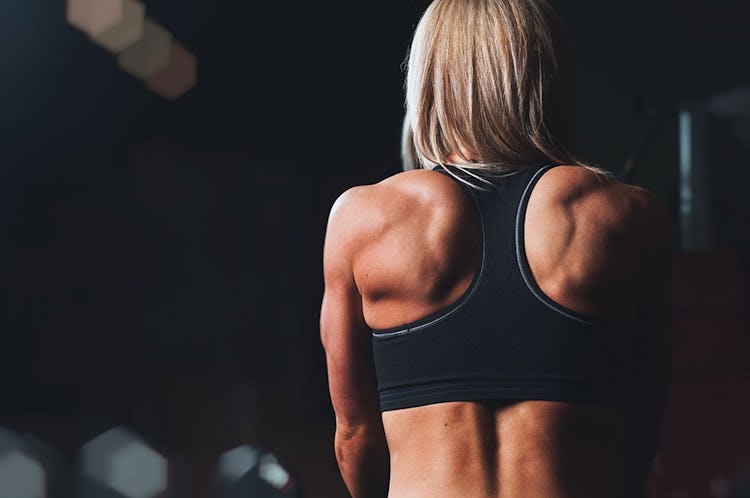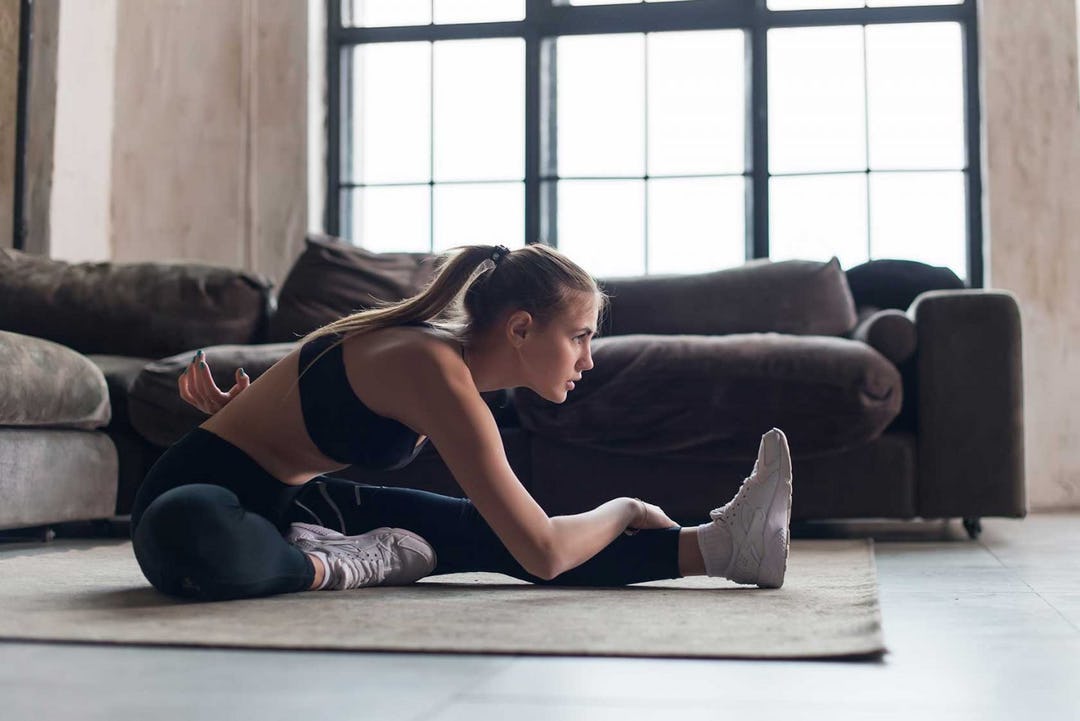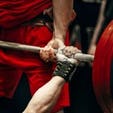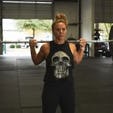Unless you’ve been living under a proverbial rock, you’ve surely seen the “You have as many hours a day as Beyonce” memes on Facebook or Instagram. It’s a strong reminder that if Queen Bey can manage all her appointments and obligations—including keeping her booty tight—so can you.
But how can you, a mere mortal (but still a boss b*tch) do the same? The answer is full-body workouts.
More likely than not, switching to a full-body routine will build more muscle, burn more fat, and get you out of the gym faster than the one you’ve been doing. So you’ll have plenty of time to record your album, start a fashion line, and star in a blockbuster movie.
We talked to wife, mom, and Onnit Coach Nikita Fear (also an Equinox Tier X Coach/EFTI Master Instructor) about how to get the best results from the least amount of time spent in the gym.
Full-Body Workout Benefits for Women

When most people start working out, they train one or two body parts at a time, or focus only on the ones they most want to enhance. Body-part training splits have their place, but if you want to get in and out of the gym fast—and have fewer overall workouts per week—you should get in the habit of training the whole body each session.
“One of the benefits of full-body programming is that you are being as efficient as possible with the time allotted,” says Fear. Training the whole body ensures that you don’t overlook or neglect any area, and it burns loads more calories than focusing on only one or two muscle groups. That means you’ll burn more fat in each session. “Blood has to pump all over your body to fuel every muscle you train,” says Fear, “so full-body workouts get your heart rate up more, and they’ll improve your cardiovascular fitness.”
Full-body workouts are also great for longevity. “They allow you to get more connected to your body,” says Fear. “In life, we don’t move in parts, but as a whole. So when we train to move that same way in a workout, it helps us move more fluidly in life.” To that end, the workouts that Fear designed below feature several combination lifts, such as Romanian deadlifts that finish with a row, split squats that end with a biceps curl, and rows from a plank position, so you mimic more movements you’ll do in real life. They also have you doing your exercises in circuit fashion, meaning that you’ll go from one exercise to the next with little rest in between. Within one round of any circuit, you’ll have trained nearly every muscle in your body.
How Often Should I Do a Full-Body Workout?
Fear says three workouts per week is enough when you’re training the whole body each time. Depending on the exercises you choose, and how you organize the workouts, you could train more frequently if you like, doing as many as five sessions per week. But if you’re a beginner exerciser, or new to full-body training, start with three non-consecutive training days (such as Monday, Wednesday, and Friday).
Remember that muscles recover and grow when they’re resting between workouts. So if you train every muscle group on Monday, there’s no need to do it all again on Tuesday. One of the great benefits of full-body training is that, if you miss a workout, you won’t fall behind. Let’s say you train the whole body on Monday. If you have to miss Wednesday’s workout, but you plan to train again on Friday, you’ll only have gone three days without training. You won’t lose any progress in that short time. In comparison, imagine doing a body-part split where you usually train legs on Wednesday. If you miss that workout, a whole week may go by before you can train legs again, or you’ll have to re-shuffle your training schedule to fit in the leg day, and some other body part will suffer.
Yet another bonus of full-body workouts is the rapid strength you can gain from them. In a full-body program, you typically only do one or two exercises for a particular muscle group in a single session (doing any more won’t leave time to hit the other areas of your body). So, every time you train shoulders, for instance, you’ll be able to work them with the heaviest possible weights and the greatest focus. With body-part splits, in which you might do five different shoulder exercises on “shoulder day,” what typically happens is that you’ll hit the first exercise or two hard, and then be too fatigued to push yourself on the remaining lifts. When you train full-body, each muscle group is fresh when you go to train it, and you can work it with the greatest intensity.
If you think working a body part with only an exercise or two in a session isn’t enough to make it respond, consider the big picture. If you do three sets for your shoulders on Monday, two more sets Wednesday, and five sets on Friday (just for example), that’s 10 sets overall for the week. Not only is that plenty of training volume for one week, each set will be done with your best effort, and that leads to the best results.
Training with such frequency, however, does require that you prioritize recovery. In addition to resting a day between sessions, choose exercises that vary in intensity, so you’ll minimize the risk of muscle strains and joint stress. Staying with the shoulder example, you could do a heavy, compound movement like dumbbell presses on Monday, relatively easy lateral raises on Wednesday, and bodyweight pushups from a downward-dog position on Friday.
In short, the more often you can train a muscle—and still let it recover—the faster you can see results. A 2015 study in the Journal of Strength and Conditioning Research found that subjects who trained the whole body three days per week gained more arm muscle than another group who trained each muscle group just once per week.
Beginner Full-Body Workout for Women
If you’re new to strength training, start here. This routine, designed by Fear, uses basic but challenging exercises, so don’t worry if you can’t do a full pushup yet or are unable to lift your bodyweight on a chinup. We’ve modified some of the classic beginner exercises so that you can train as hard as possible at your own level.
How To Stretch Before A Beginner Full-Body Workout
Perform the following exercises as a warmup. They increase mobility in the joints that are typically the most restricted, help to raise your body temperature, and will prepare your nervous system for the work ahead.
Gecko
Reps: 5–8 (each side)
Step 1. Get on all fours with your hands under your shoulders and knees beneath your hips. Draw your shoulders back and downward (think “proud chest”), and tuck your tailbone slightly so that your pelvis is perpendicular to the floor. Brace your core.
Step 2. Raise your left leg 90 degrees out to the left side while simultaneously raising your right arm out to your side with elbow bent 90 degrees.
Step 3. Lower, and repeat for reps. Then repeat on the opposite side.
Squat to Stand
Reps: 5–8
Step 1. Stand with feet about hip-width apart. Drive your hips back and down, sending your butt into a deep, low squat just inches from the ground. As you drive your hips back, shoot your arms straight out in front of your body to around shoulder height.
Step 2. From this position, reach your arms down and grasp your toes. Hold on to your toes as you straighten out your knees as much as you can, sending your hips up to the ceiling. Finish with your body bent at the hips and your legs almost straight with a soft bend at the knees.
Step 3. Return to the low squat position, and then squeeze your glutes to stand up tall again.
Chaturanga Flow
Reps: Perform the exercise for 30 seconds
Step 1. Get into a downward dog pose with your toes pressing firmly into the floor, and your hands pressing your butt up and back toward the ceiling.
Step 2. Bring your hips forward into a plank position (body in a straight line), and, keeping your arms tight to the body, lower your chest to the floor as in a pushup.
Step 3. From this position, extend your arms while arching your back and dropping your hips to the floor (upward dog).
Step 4. Lift the hips up and back to starting, downward-dog position.
Mobile Table
Reps: Perform the exercise for 30 seconds
Step 1. Sit on the floor with your feet in front of you and knees bent 90 degrees. Place your hands on the floor behind you with your fingers pointing forward.
Step 2. Push through your heels to extend your hips to lockout, so you end up in a tabletop position.
Step 3. Lower your hips back down and behind you. The motion should look like you’re swinging your hips back. Use momentum to begin the next rep.
Alternating Shin Box
Reps: Perform the exercise for 30 seconds
Step 1. Sit on the floor and with your left leg in front and your right behind you, knees bent, so that your left foot is directly in front of the right knee.
Step 2. Twist your torso to the right, raising your right knee up 90 degrees. Continue turning to the opposite side so that your right foot ends up in front of your left knee on the floor. If you need to, use your arms on the floor behind your body to help you shift from one side to the other.
Workout Directions
The workout is made up of two circuits. To perform a circuit, do one set of each movement in order, resting as little as possible between exercises. When you come to the end of the circuit, rest as needed, and then repeat the circuit for 2 to 3 total rounds. Complete all sets for the first circuit before you go on to the second one.
Circuit #1
1. Romanian Deadlift to Row
Reps: 10–12
Step 1. Hold a dumbbell in each hand and stand with feet hip-width apart. Draw your shoulders back and downward (think “proud chest”), and tuck your tailbone slightly so that your pelvis is parallel to the floor. Brace your core.
Step 2. Bend your hips back while keeping a long spine from your head to your pelvis. Allow your knees to bend as needed, and stop when you feel a stretch in your hamstrings.
Step 3. From there, row the weights to your sides. Lower them back down, and then extend your hips to stand up tall again.
2. Goblet Squat
Reps: 10–12
Step 1. Stand with feet hip-width apart. Hold a single dumbbell at your chest with both hands, just underneath your chin. Your shoulders should be back and down—proud-chest position.
Step 2. Brace your core. Keeping a long spine from your head to your pelvis, sit back and spread your knees apart to squat down as deeply as you can without losing alignment.
Step 3. Squeeze your glutes as you come back up to standing.
3. Inverted Row
Reps: 10–12
Step 1. Set a bar in a rack at about hip level. Grasp the bar with hands shoulder-width apart, and hang from it with your legs extended in front of you. (To make it less challenging, bend your knees 90 degrees and plant your feet on the floor.) Draw your shoulders down and back, and brace your core so that your body forms a straight line from your head to your feet.
Step 2. Pull your body up to the bar, squeezing the shoulder blades together, until your chest touches it. Lower back down to the starting position.
Circuit #2
1. Split Squat with Bicep Curl
Reps: 10–12 (each side)
Step 1. Hold a dumbbell in each hand and stagger your stance so that your left leg is forward and your right is behind you.
Step 2. Lower your body into a lunge, until each knee is bent 90 degrees. As you go down, simultaneously curl the dumbbells with a neutral grip (both palms face in). Allow your arms to come forward a bit as you curl so that the weights stop at the front of your shoulders. Complete your reps, and then switch sides and repeat.
2. Kneeling or Full Push Up
Reps: 10–12
Step 1. Get into a pushup position on the floor with hands under your shoulders and legs extended behind you. (If regular pushups are too hard, rest your knees on the floor as shown above. Either way, make sure your body forms a straight line.) Shoulders are pulled back and down, and tailbone slightly tucked so that your pelvis is perpendicular to your spine.
Step 2. Lower your body until your chest is just above the floor. Tuck your elbows close to your sides as you descend, and then push yourself back up.
3. Kneeling or Full-Length Side Plank
Reps: Hold for 20–60 seconds (each side)
Step 1. Lie on the floor on your right side and rest your forearm on the floor. Extend your legs, aligning your body from head to feet.
Step 2. Bridge your hips up, so that you balance on your forearm and the edge of your right foot. Your legs should be stacked directly on top of each other. If that’s too easy, extend your left arm toward the ceiling to challenge your balance more, as shown above. If the plank is too hard to hold with legs straight, you can bend your knees 90 degrees. Hold for 20–60 seconds, and then switch sides and repeat.
Decompression/Cool Down
Finish your workout with the scorpion, designed to open up the hips and T-spine.
Alternating Floor Scorpion
Reps: 5 (each side)
Step 1. Lie on your stomach on the floor with your arms outstretched.
Step 2. Lift your left leg up and twist it over to the right side of your body, turning your hips to put your foot on the floor. Push your knee out as much as you can, ideally so that it points straight up to the ceiling. Your left shoulder will come off the floor as you twist, but try to keep the left arm reaching out so that it doesn’t come up more than it has to. Create as good a stretch as possible.
Step 3. Reverse the movement and repeat on the opposite side.
Bodyweight Full-Body Workout for Women
If the only gym you have access to is your living room, you can still get stronger and more defined—and we don’t mean by doing more reps with your couch cushions. This routine from Fear requires only your bodyweight.
How To Stretch Before A Bodyweight Full-Body Workout
Perform the following exercises as a warmup. They increase mobility in the joints that are typically the most restricted, help to raise your body temperature, and will prepare your nervous system for the work ahead.
Mountain Climber with Sky Reach
Reps: 10 (each side)
Step 1. Get on all fours with your hands under your shoulders and knees beneath your hips. Draw your shoulders back and downward (think “proud chest”), and tuck your tailbone slightly so that your pelvis is perpendicular to the floor. Brace your core.
Step 2. Bring your left foot up to the outside of your left hand. Maintian your long spine and shoulder and pelvis position.
Step 3. From there, twist your torso to the left, stretching the left arm toward the ceiling. Hold for a moment, and then return your hand to the floor. Return your left knee to the floor. Repeat on the opposite side.
Alternating Sit-Through
Reps: 10 (each side)
Step 1. From the all-fours (table top) position, push your hands into the floor and raise your knees off the floor so that they hover. Brace your core.
Step 2. Twist your body to the right, raising your right hand off the floor and kicking your left leg straight out to the right side. You should be holding your body weight off the floor using your left hand and right foot.
Step 3. Return to starting position, and repeat on the opposite side.
Standing Side Bend and Arm Reach
Reps: 10 (each side)
Step 1. Stand with your arms out to your sides and elbows bent 90 degrees—your left arm pointing up and the right pointing down.
Step 2. Bend your hips to the left side as you stretch your left arm over your head to the opposite side of your body. At the same time, reach your right arm down and across your body.
Step 3. Reverse the motion and repeat on the opposite side.
Beast to Alternating Knee Tap
Reps: 10 (each side)
Step 1. Get into a child’s pose—knees on the floor, arms stretched in front of you, and your weight back on your heels.
Step 2. Push yourself up into a pushup position as you bring your left knee forward to touch your left elbow.
Step 3. Return to the child’s pose, and then repeat on the opposite side.
Workout Directions
The workout is made up of two circuits. To perform a circuit, do one set of each movement in order, resting as little as possible between exercises. When you come to the end of the circuit, rest as needed, and then repeat the circuit for 2 to 3 total rounds. Complete all sets for the first circuit before you go on to the second one.
Circuit #1
1. Drop Lunge to Lateral Lunge
Reps: 12 (each leg)
Step 1. Begin standing with your feet about hip-width apart.
Step 2. Lunge out to the right side and bend your hips back, lowering your body until your right leg is bent about 45 degrees. Keep your left leg straight as you drop into the lunge. Your shoulders should be pulled back and down (think “proud chest”) as you lower.
Step 3. Push off your right foot to come back up, but instead of returning to the standing position, cross your right foot behind your left leg and plant it outside your left foot.
Step 4. Bend both knees to lower into a lunge, stopping when your rear knee is just above the floor. That’s one rep. Complete your reps on that side, and then switch sides.
2. Pushup to Bent-Knee Downward Dog
Reps: 12
Step 1. Begin in a downward dog position: balancing on the balls of your feet with your arms pressing into the floor and hips pushed back so they point to the ceiling. You must keep your head, spine and pelvis aligned, so if you feel a big stretch in your hamstrings that makes you want to tuck your tailbone under, bend your knees a bit so that you can tilt your butt up higher.
Step 2. Bring your hips down into a pushup position, so your body forms a straight line that’s level with the floor. If you need to, rest your knees on the floor as shown above. If you can do a pushup with legs straight, lower your body to the floor, tucking your elbows to the sides of your body. Stop when your chest is just above the floor.
Step 3. Press yourself back up, using the momentum to help send your weight backward and return to the downward dog position. That’s one rep.
If you’re doing the regular pushup, and you find yourself tiring out before you’ve completed all your reps, you can switch to the knees-down pushup to complete the set.
3. Kneeling or Full-Length Side Plank
Reps: Hold for 20–30 sec. (each side)
Step 1. Lie on the floor on your right side and rest your forearm on the floor. Extend your legs, aligning your body from head to feet.
Step 2. Bridge your hips up, so that you balance on your forearm and the edge of your right foot. Your legs should be stacked directly on top of each other. If that’s too easy, extend your left arm toward the ceiling to challenge your balance. If the plank is too hard to hold with legs straight, you can bend your knees 90 degrees. Hold for 20–30 seconds, and then switch sides and repeat.
Circuit #2
1. Sit-Through to Bridge
Reps: 6 (each side)
Step 1. Start on all fours with your hands beneath your shoulders and your knees under your hips. Your back should be flat.
Step 2. Brace your core and push your hands into the floor, raising your knees a few inches off the floor so they hover.
Step 3. Twist your body to the left, raising your left hand off the floor to allow your hips to turn. As you twist, extend your right leg straight out the the left side. You should be holding your body off the floor using your right hand and left foot so that your butt doesn’t touch the floor.
Step 4. Drive your hips up to full extension, squeezing your glutes at the top. Return to the starting position, and repeat on the opposite side.
2. Mobile Table
Reps: 15–20
Step 1. Sit on the floor with your feet in front of you and knees bent 90 degrees. Place your hands on the floor behind you with your fingers pointing forward.
Step 2. Push through your heels to extend your hips to lockout, so you end up in a tabletop position.
Step 3. Lower your hips back down and behind you. The motion should look like you’re swinging your hips back. Use momentum to begin the next rep.
3. Alternating Single-Leg Extension
Reps: 15–20 (each leg)
Step 1. Lie on your back on the floor. Anchor your body by holding on to something sturdy, such as a bench, couch, or ottoman behind you.
Step 2. Bring your knees to your chest and brace your core.
Step 3. Extend one leg while keeping the other bent. Return your leg to the starting position, and repeat with the other leg.
Decompression/Cool Down
Finish your workout with the angled child’s pose, designed to open up your back and hips.
Angled Child’s Pose
Reps: 5 (each side)
Step 1. Get on all fours and reach your right arm forward and across your body, placing the edge of your hand on the floor in front of your left hand.
Step 2. Drive your hips back and to the right side so that you feel a stretch in the right side of your back.
Step 3. Come forward again and repeat for reps. Then repeat on the opposite side.
Alternating Floor Scorpion
Reps: 5 (each side)
Step 1. Lie on your stomach on the floor with your arms outstretched.
Step 2. Lift your left leg up and twist it over to the right side of your body, turning your hips to put your foot on the floor. Push your knee out as much as you can, ideally so that it points straight up to the ceiling. Your left shoulder will come off the floor as you twist, but try to keep the left arm reaching out so that it doesn’t come up more than it has to. Create as good a stretch as possible.
Step 3. Reverse the movement and repeat on the opposite side.
Advanced Full Body Workout for Women
If you’ve been training for six months or more, Fear says this workout will push you to the next level. The exercises are more complex and will allow you to lift heavier—while challenging your balance and flexibility—for greater gains.
How To Stretch Before An Advanced Full-Body Workout
Perform the following exercises as a warmup. They increase mobility in the joints that are typically the most restricted, help to raise your body temperature, and will prepare your nervous system for the work ahead.
Gecko
Reps: 5–8 (each side)
Step 1. Get on all fours with your hands under your shoulders and knees beneath your hips. Draw your shoulders back and downward (think “proud chest”), and tuck your tailbone slightly so that your pelvis is perpendicular to the floor. Brace your core.
Step 2. Raise your left leg 90 degrees out to the left side while simultaneously raising your right arm out to your side with elbow bent 90 degrees.
Step 3. Lower, and repeat for reps. Then repeat on the opposite side.
Chaturanga Flow
Reps: Perform the exercise for 30 seconds
Step 1. Get into a downward dog pose with your toes pressing firmly into the floor, and your hands pressing your butt up and back toward the ceiling.
Step 2. Bring your hips forward into a plank position (body in a straight line), and, keeping your arms tight to the body, lower your chest to the floor as in a pushup.
Step 3. From this position, extend your arms while arching your back and dropping your hips to the floor (upward dog).
Step 4. Lift the hips up and back to the starting, downward-dog position.
Mobile Table
Reps: Perform the exercise for 30 seconds
Step 1. Sit on the floor with your feet in front of you and knees bent 90 degrees. Place your hands on the floor behind you with your fingers pointing forward.
Step 2. Push through your heels to extend your hips to lockout, so you end up in a tabletop position.
Step 3. Lower your hips back down and behind you. The motion should look like you’re swinging your hips back. Use momentum to begin the next rep.
Alternating Shin Box
Reps: Perform the exercise for 30 seconds
Step 1. Sit on the floor and with your left leg in front and your right behind you, knees bent, so that your left foot is directly in front of the right knee.
Step 2. Twist your torso to the right, raising your right knee up 90 degrees. Continue turning to the opposite side so that your right foot ends up in front of your left knee on the floor. If you need to, use your arms on the floor behind your body to help you shift from one side to the other.
Workout Directions
The workout is made up of two circuits. To perform a circuit, do one set of each movement in order, resting as little as possible between exercises. When you come to the end of the circuit, rest as needed, and then repeat the circuit for 2 to 3 total rounds. Complete all sets for the first circuit before you go on to the second one.
Circuit #1
1. Single-Leg Romanian Deadlift
Reps: 12–15 (each leg)
Step 1. Hold a dumbbell in each hand and stand on your right foot. Draw your shoulder blades down and together (think “proud chest”), and tuck your tailbone under slightly so that your pelvis is parallel to the floor.
Step 2. Begin bending your hips backward so that your torso moves toward the floor. Keep your head, spine, and pelvis aligned as you move, and allow your right knee to bend as needed. Your left leg will naturally extend behind you—squeeze the glutes on that side as it does.
Step 4. Try to keep your hips level with the floor, but it’s OK if your left toes rotate outward a little. Maintain your proud chest position—the weight will try to pull your shoulders forward, so fight to keep them locked back and down. Bend as far as you can without losing your alignment.
Step 5. Squeeze your glutes as you come back up, extending your hips to lockout. You can touch your left foot down for a moment if you need to regain your balance, and then begin the next rep.
2. Deficit Reverse Lunge
Reps: 12–15 (each leg)
Step 1. Stand on a box or step that raises you a few inches off the floor.
Step 2. Reach your right leg behind you and plant it on the floor. Reach both arms in front of you to help you balance, and lower your body with control until your rear knee nearly touches the floor.
Step 3. Drive through the left foot to stand up and bring the right foot back to the box. Complete your reps, and then switch legs and repeat.
3. Underhand-Grip Pulldown
Reps: 8–10
Step 1. Sit at a lat-pulldown station and grip the bar with palms facing you, hands shoulder-width apart. Secure your knees under the pad.
Step 2. Pull the handle to your collarbone, driving your elbows down and back and squeezing your lats. Control the weight on the way back up, and let it stretch your back at the top.
Circuit #2
1. Elevated Single-Leg Hip Thrust
Reps: 10–12 (each leg)
Step 1. Place a bench, box, or step that will elevate your foot a few inches above the floor; set another one behind it that’s even taller. Rest your upper back on the taller bench and place your left foot on the smaller one. Your hips and knees should be bent 90 degrees.
Step 2. Brace your core and drive through your left heel to extend your hips to lockout. Keep your right knee pulled to your chest as you rise. Control the descent back to the starting position. Do not let your butt rest on the floor between reps. Complete your reps, and then switch sides and repeat.
2. Single-Arm Row from Plank
Reps: 8–10 (each side)
Step 1. Hold a dumbbell in your left hand and place your right forearm on a bench, box, or step that elevates a surface a foot or so above the floor. Extend your legs behind you as in a pushup position and tuck your tailbone slightly so that your pelvis is perpendicular to your spine. Use as wide a stance as you need to maintain balance (the narrower you go, the more challenging it will feel).
Step 2. Brace your core. Keeping your body in a straight line from your head to your heels, row the left-hand dumbbell to your side. Avoid twisting your body—keep your shoulders square to the floor.
3. Narrow-Grip Pushup
Reps: 10–12
Step 1. Get into a pushup position on the floor, legs extended behind you. Move your hand placement in slightly so your hands line up with your chest (rather than your shoulders). Make sure your body forms a straight line. Shoulders pulled back and down, and tailbone slightly tucked so that your pelvis is perpendicular to your spine.
Step 2. Lower your body until your chest is just above the floor. Tuck your elbows close to your sides as you descend, and then push yourself back up.
Decompression
Finish your workout with the scorpion, designed to open up the hips and T-spine.
Alternating Floor Scorpion
Reps: 5 (each side)
Step 1. Lie on your stomach on the floor with your arms outstretched.
Step 2. Lift your left leg up and twist it over to the right side of your body, turning your hips to put your foot on the floor. Push your knee out as much as you can, ideally so that it points straight up to the ceiling. Your left shoulder will come off the floor as you twist, but try to keep the left arm reaching out so that it doesn’t come up more than it has to. Create as good a stretch as possible.
Step 3. Reverse the movement and repeat on the opposite side.
For another full-body workout that uses kettlebells, click HERE.

)






